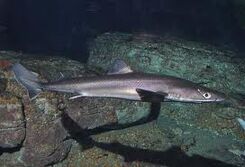
Kitefin Shark
The Kitefin Shark is a species of dogfish shark in the family Dalatiidae, and the only species in its genus. It is found sporadically around the world, usually close to the sea floor at depths of 200–600 m (660–2,000 ft). With a sizable oil-filled liver to maintain neutral buoyancy, this shark is able to cruise slowly through the water while expending little energy. The kitefin shark has a slender body with a very short, blunt snout, large eyes, and thick lips. Its teeth are highly differentiated between the upper and lower jaws, with the upper teeth small and narrow and the lower teeth large, triangular, and serrated. Its typical length is 1.0–1.4 m (3.3–4.6 ft).
Description[]
The kitefin shark has a moderately elongated body with a very short, rounded snout. The eyes and spiracles are large. The lips are thick with pleats or fringes, though are not modified to be suctorial. There are 16–21 tooth rows in the upper jaw and 17–20 tooth rows in the lower jaw. The upper teeth are small and spike-shaped, curving slightly towards the corners of the mouth. The lower teeth are very large, knife-shaped, and serrated, with their bases interlocking to form a continuous cutting surface.
The first dorsal fin is slightly smaller and shorter-based than the second, and neither has spines. The first dorsal fin originates behind the free rear tip of the pectoral fins, while the second originates above the middle of the pelvic fin bases. The pectoral fins are short and rounded. The caudal fin has a prominent upper lobe with a well-developed notch near the tip, and a barely present lower lobe. The form and arrangement of the fins is similar to the Portuguese dogfish (Centroscymnus coelolepis), from which this species can be distinguished by the lack of fin spines. The dermal denticles are small and flat, with a single horizontal ridge ending in a point.
The coloration is a uniform dark brown or gray, sometimes with faint black spots on the back. The fins have white or translucent margins, and the tip of the caudal fin is black. An 90 cm (3.0 ft) long kitefin shark with partial albinism, lacking pigment on 59% of its body, was caught in the Gulf of Genoa in 2003. Unlike in a previous case of an albino Portuguese dogfish, the abnormal coloration of this individual had not diminished its ability to capture prey. Most kitefin sharks are 1.0–1.4 m (3.3–4.6 ft) long and weigh 8 kg (18 lb); the maximum reported length is 1.6 m (5.2 ft), possibly 1.8 m (5.9 ft).
Habitat[]
An offshore, deepwater species, the kitefin shark is most common at a depth of 200–600 m (660–2,000 ft), but has been captured from the surface to as deep as 1,800 m (5,900 ft). Off the Azores this shark segregates by sex, with females most common around a depth of 230 m (750 ft) and males most common around 412–448 m (1,352–1,470 ft). The kitefin shark inhabits the outer continental shelves and upper continental slopes, and is also found around oceanic islands and seamounts. It is the only member of its family that tends to be found close to the sea floor as opposed to in the middle of the water column, though on occasion it has been captured well above the bottom.
Food[]
It feeds mainly on bony fishes (including deepwater smelts, viperfishes, scaly dragonfishes, barracudinas, greeneyes, lanternfishes, bristlemouths, cod and other gadids, grenadiers, deepwater scorpionfishes, bonito, snake mackerels, deepwater cardinalfishes, and sea toads), but also takes a wide variety of other animals, including skates, smaller sharks (Galeus, Squalus, Etmopterus and Centrophorus), squid and octopus, crustaceans (amphipods, isopods, shrimp and lobsters), polychaete worms, and siphonophores.
